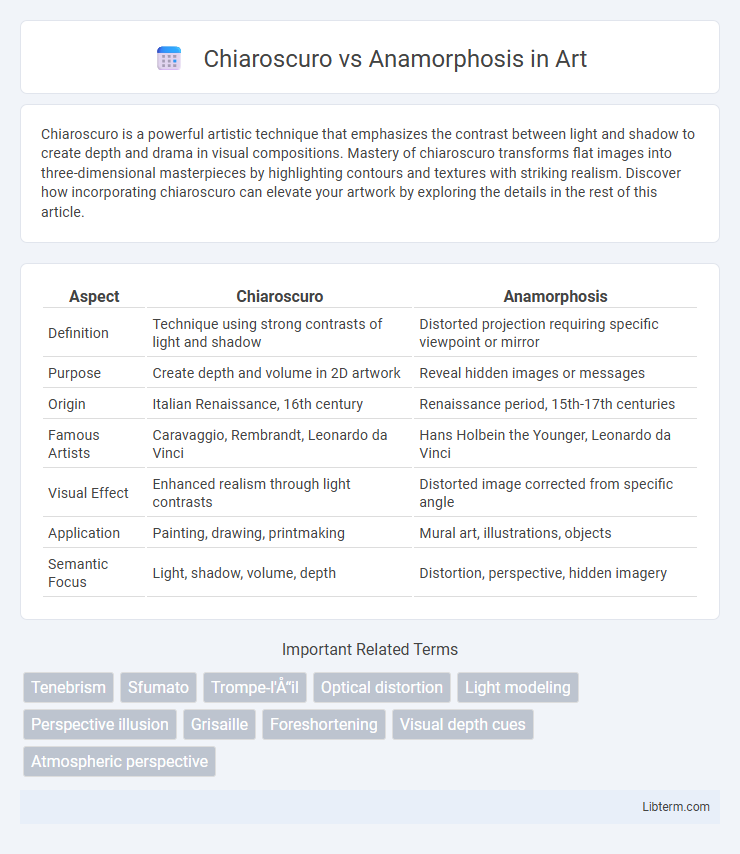Chiaroscuro is a powerful artistic technique that emphasizes the contrast between light and shadow to create depth and drama in visual compositions. Mastery of chiaroscuro transforms flat images into three-dimensional masterpieces by highlighting contours and textures with striking realism. Discover how incorporating chiaroscuro can elevate your artwork by exploring the details in the rest of this article.
Table of Comparison
| Aspect | Chiaroscuro | Anamorphosis |
|---|---|---|
| Definition | Technique using strong contrasts of light and shadow | Distorted projection requiring specific viewpoint or mirror |
| Purpose | Create depth and volume in 2D artwork | Reveal hidden images or messages |
| Origin | Italian Renaissance, 16th century | Renaissance period, 15th-17th centuries |
| Famous Artists | Caravaggio, Rembrandt, Leonardo da Vinci | Hans Holbein the Younger, Leonardo da Vinci |
| Visual Effect | Enhanced realism through light contrasts | Distorted image corrected from specific angle |
| Application | Painting, drawing, printmaking | Mural art, illustrations, objects |
| Semantic Focus | Light, shadow, volume, depth | Distortion, perspective, hidden imagery |
Introduction to Chiaroscuro and Anamorphosis
Chiaroscuro emphasizes the dramatic interplay of light and shadow to create depth and volume in two-dimensional artwork, enhancing realism and emotional intensity. Anamorphosis involves distorted projection or perspective requiring specific vantage points or mirrors for the image to appear correctly, often used to challenge perception and engage viewers interactively. Both techniques manipulate visual perception, with chiaroscuro focusing on tonal contrast and anamorphosis on spatial distortion.
Historical Origins of Chiaroscuro
Chiaroscuro, emerging during the Renaissance in the early 15th century, is an artistic technique that contrasts light and shadow to create a sense of volume and three-dimensionality in painting and drawing. Developed by artists such as Leonardo da Vinci and Caravaggio, chiaroscuro enhanced the realism and emotional intensity of visual artworks by manipulating light sources to shape forms. This technique contrasts with anamorphosis, which originated later as a distorted projection requiring specific viewpoints or mirrors for proper visualization.
The Evolution of Anamorphosis in Art
Anamorphosis evolved from early Renaissance experiments in perspective to complex illusions in contemporary art, showcasing distorted images that require specific viewpoints or mirrors to be understood. Artists like Hans Holbein the Younger popularized anamorphic art in the 16th century with works such as "The Ambassadors," which uses skewed angles to conceal a skull, symbolizing mortality. Modern evolutions incorporate digital technology and interactive installations, pushing the boundaries of spatial perception and viewer engagement far beyond traditional chiaroscuro techniques that rely on light and shadow contrast.
Key Techniques in Chiaroscuro
Chiaroscuro employs the key technique of strong contrasts between light and dark to create a sense of volume and three-dimensionality in two-dimensional art. Artists manipulate shading and shadow gradations to emphasize depth, texture, and form, often highlighting dramatic effects in portraits or still lifes. This technique relies on precise control of light sources to model shapes realistically, distinguishing it from the perspective distortions used in anamorphosis.
Understanding Perspective in Anamorphosis
Anamorphosis relies on a distorted perspective that requires the viewer to occupy a specific vantage point or use a reflective device to reveal an accurate image, contrasting with chiaroscuro's emphasis on light and shadow to create depth on a flat surface. Understanding perspective in anamorphosis involves comprehending the geometric principles and optical illusions that manipulate spatial perception, transforming fragmented or stretched visuals into coherent forms. This artistic technique challenges traditional representation by engaging spatial awareness and cognitive interpretation to convey hidden or altered realities.
Notable Artists Who Used Chiaroscuro
Notable artists who mastered chiaroscuro include Caravaggio, whose dramatic use of light and shadow revolutionized Baroque painting, and Rembrandt, renowned for his deep contrasts that enhance emotional intensity. Leonardo da Vinci employed chiaroscuro to create lifelike three-dimensional effects, while Georges de La Tour's work is distinguished by his subtle and powerful interplay of light. These artists exploited chiaroscuro to intensify realism and evoke profound visual narratives in their compositions.
Famous Examples of Anamorphic Art
Famous examples of anamorphic art include Hans Holbein the Younger's "The Ambassadors," featuring a distorted skull visible only from a specific angle, demonstrating the intricate use of perspective in Renaissance painting. Another notable instance is the street art of Leon Keer, who creates large-scale, 3D anamorphic illusions that transform flat surfaces into dynamic scenes when viewed from particular vantage points. These works contrast with chiaroscuro techniques, which emphasize light and shadow to model form without relying on perspective distortion.
Visual Effects: Contrast vs. Distortion
Chiaroscuro relies on stark contrast between light and shadow to create a three-dimensional, dramatic effect that enhances depth and volume in visual compositions. Anamorphosis employs deliberate distortion to manipulate perception, requiring the viewer to observe from a specific angle or use a reflective device for the image to appear correctly proportioned. While chiaroscuro intensifies visual impact through tonal contrast, anamorphosis challenges visual perception through spatial distortion and optical illusion.
Artistic Impact and Influence Today
Chiaroscuro, characterized by its dramatic use of light and shadow, profoundly influences contemporary visual storytelling by enhancing depth and emotional intensity in media such as film, photography, and digital art. Anamorphosis challenges perception through distorted images that require specific viewpoints or devices to reveal hidden content, inspiring interactive and immersive art installations and augmented reality experiences. Both techniques continue to shape artistic innovation by engaging viewers in unique ways--Chiaroscuro through mood and realism, and Anamorphosis through perspective and discovery.
Comparing Chiaroscuro and Anamorphosis: Key Differences
Chiaroscuro emphasizes the artistic technique of using strong contrasts between light and dark to create the illusion of volume and depth in two-dimensional artwork. Anamorphosis involves distorting an image so it appears normal only when viewed from a specific angle or with a particular mirror, focusing on visual perception and perspective manipulation. The key difference lies in chiaroscuro's enhancement of three-dimensional form through tonal contrast, while anamorphosis relies on optical illusion and spatial distortion for its effect.
Chiaroscuro Infographic

 libterm.com
libterm.com